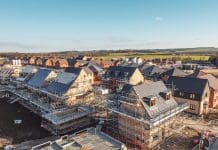The UK has launched the first cross-industry Net Zero Carbon Buildings Standard (UK NZC Building Standard), and experts in the industry have given their opinion
The UK launched the UK NZC Building Standard yesterday, taking a step closer to its net zero carbon goals.
Various experts from the industry have reacted to the pilot scheme and offered their opinion.
The UK NZC Building Scheme is heavily supported
The new standard consolidates the requirements for a building to declare itself as a net zero building. Until now, there has been no universal methodology or standard across the industry.
The standard marks a turning point in the construction industry’s effort to decarbonise, and is supported by BBP, BRE, the Carbon Trust, CIBSE, IStructE, LETI, RIBA, RICS, and UKGBC.
Industry expert reactions
Will Arnold, head of Climate Action at IStructE, sees the Standard as a pivotal moment for the UK construction industry, stating: “As the UK construction industry continues its decarbonisation journey, the launch of the UK Net Zero Carbon Buildings Standard is a game-changer, providing long-needed clarity on what it means to design and build in alignment with the UK’s 2050 net zero laws.
“Developed through collaboration across multiple industry bodies, the Standard sets out clear, measurable limits for both operational and embodied carbon, helping ensure our buildings meet the 1.5°C climate trajectory. This is a vital step forward, offering engineers and designers a unified framework to help drive decarbonisation across all sectors of the built environment.”
For civil and structural engineers like Charles Rothnie, senior engineer and member of the Net Zero Carbon Group at Perega, the Standard represents a significant step in aligning industry practices: “The launch of the Net Zero Carbon Building Standard represents important progress in the UK’s pathway to Net Zero. This industry-agreed standard can be used by anyone wanting to demonstrate that their building is Net Zero Carbon, and potentially used by policymakers to set Net Zero requirements.
“The aim is that achieving agreed targets and limits will become normal for most of the UK’s buildings in the future.”
Rothnie further underscores the responsibility of engineers in this process, emphasising: “As civil and structural engineers, we realise that the decisions we make and the designs we produce have a significant impact on embodied carbon. The performance limits stated in the standard will ensure that as an industry, we’re all working together to an agreed methodology.”














